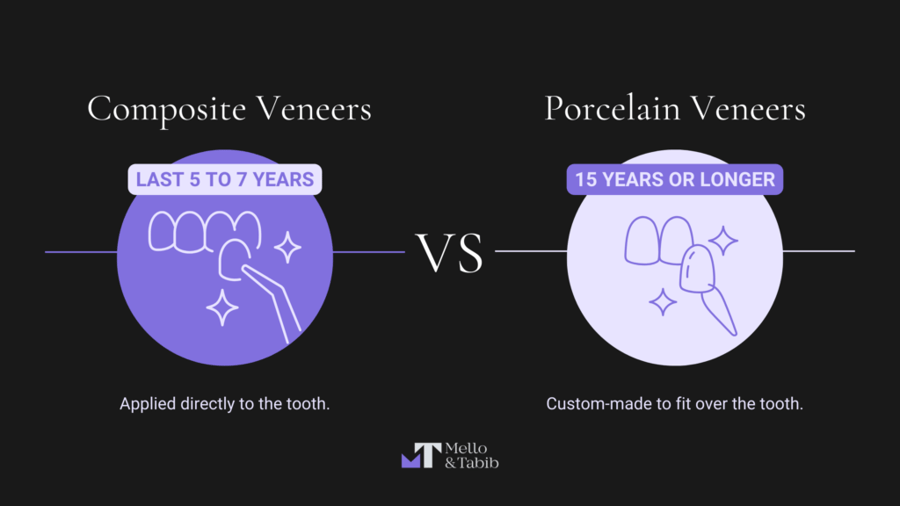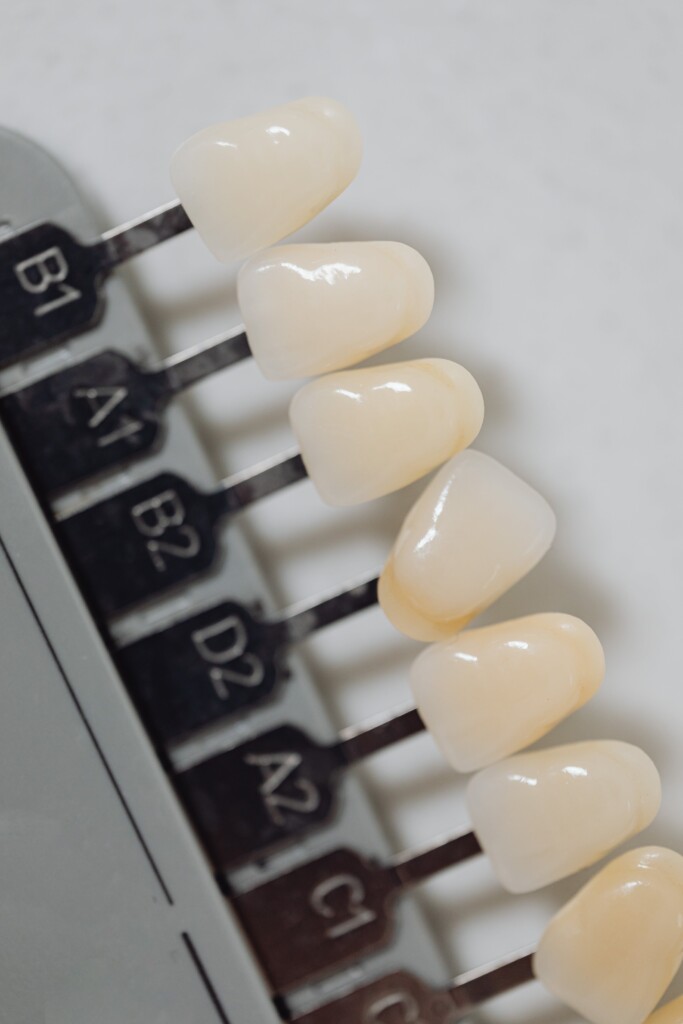Composite Bonded Veneer vs Porcelain Veneer
December 20th, 2023
4 min read

The world of cosmetic dentistry offers many solutions for those seeking to enhance their smiles. Among the most sought-after treatments are veneers, thin shells designed to cover the front surface of teeth, offering an instant smile transformation. However, with options like composite bonded veneers and porcelain veneers available, how does one decide which is the best fit?
At NYC Smile Design, we’ve guided countless individuals through this decision, ensuring they’re equipped with the knowledge to choose confidently. In this guide, we’ll dive into the pros and cons of both veneer types, helping you chart the path to your dream smile.
What is a Composite Bonded Veneer?
Composite bonded veneers, often referred to as “composite veneers,” are made from a tooth-colored resin material. This resin is applied directly to the tooth and sculpted to achieve the desired shape and appearance. The process is relatively quick, often completed in a single visit, and requires minimal tooth preparation.
Advantages of Composite Bonded Veneers
Composite veneers have become a go-to choice for many individuals looking to enhance their smiles, and there are several good reasons for this. First and foremost, they are more affordable than porcelain veneers. Composite veneers can range from between $350 to $1,500 per tooth. This cost-effectiveness means that more people can access this cosmetic treatment without breaking the bank.
In addition to being wallet-friendly, composite veneers offer a quick solution for those eager to see immediate improvements. Unlike some dental procedures that require multiple visits, you can walk into a dental clinic with your existing smile and walk out with a transformed one, all in a single appointment.
Another noteworthy benefit of composite veneers is the minimal invasion of your natural teeth. The procedure involves little to no removal of tooth enamel, which is a significant advantage for those concerned about preserving their natural teeth. This minimal intervention also means that if, for some reason, you decide to revert to your original smile, the process is often reversible.
Lastly, life happens, and sometimes dental work can get damaged. But with composite veneers, there’s no need for excessive worry. If they suffer any damage, like a small chip or a crack, repairs are straightforward. The dentist can usually mend them without much hassle, ensuring that your smile remains intact. All these benefits combined make composite veneers a versatile, economical, and efficient option for those looking to enhance their smiles.
Considerations for Composite Bonded Veneers
When considering composite veneers, it’s essential to weigh both their advantages and some of their limitations. One of the primary considerations to keep in mind is their durability. While composite veneers offer many benefits, they will not last as long as porcelain veneers. This means that over the years, you will find yourself visiting the dentist for replacements or repairs more often than you would with porcelain veneers.

Another aspect to think about is how composite veneers handle stains. We all love our morning coffee or enjoying a glass of red wine on special occasions. However, if you’re someone who frequently indulges in these or other staining beverages and foods, it’s worth noting that composite material will become discolored over time. This doesn’t mean you’ll have to give up your favorite drinks, but it’s something to be aware of when making your decision.
In essence, while composite veneers offer a quick and cost-effective solution for enhancing your smile, it’s crucial to consider these factors to ensure they align with your long-term expectations and lifestyle.
What is a Porcelain Veneer?
Porcelain veneers are thin shells made from high-quality ceramic material. They are custom-made to fit over the front surface of a tooth, providing a natural and luminous appearance. The process involves taking an impression of the teeth, which is then sent to a dental lab where the veneers are crafted. Once ready, they are bonded to the teeth.
Advantages of Porcelain Veneers
Porcelain veneers have become a popular choice for many looking to enhance their smile, and for good reasons. One of the standout features of porcelain veneers is their aesthetic appeal. They are meticulously crafted to mimic the natural look of teeth, capturing the unique translucency that natural tooth enamel possesses. This means that when you smile, it’s challenging for anyone to tell you have veneers on, giving you a boost of confidence.
In terms of longevity, porcelain veneers are a winner. They are built to last and, with the right care, can serve you well for up to 15-20 years. This makes them a long-term investment in your smile, reducing the need for frequent dental interventions.

Another significant advantage is how porcelain veneers handle everyday stains. We all have those favorite foods and drinks that, unfortunately, aren’t too kind to our teeth when it comes to staining. However, with porcelain veneers, you won’t have to worry as much. These veneers are designed to resist stains effectively, ensuring that your smile remains bright and untarnished for years. So, whether you’re a coffee lover or a tea enthusiast, porcelain veneers have got you covered, allowing you to enjoy life without constantly worrying about potential tooth discoloration.
Considerations for Porcelain Veneers
Porcelain veneers, while offering numerous benefits, come with certain considerations that individuals should be aware of before opting for them. One of the primary factors that many people weigh is the cost. Generally, porcelain veneers tend to be pricier than their composite counterparts and can range from $2,000 to $4,500 per tooth. This higher price point is due to the materials used and the intricate process involved in crafting them to perfection. It’s essential to view them as an investment in your smile, but it’s equally important to ensure they fit within your budget.
Another aspect to consider is the nature of the procedure itself. Opting for porcelain veneers means committing to a permanent change. This is because the process involves removing a thin layer of your natural tooth enamel to ensure the veneer fits seamlessly. Once this enamel is removed, there’s no going back, making the procedure irreversible. It’s crucial to be certain about your decision and understand the long-term implications.
Lastly, if you’re someone who’s always on the go and values quick solutions, it’s worth noting that getting porcelain veneers isn’t a one-day affair. The entire process typically requires at least two visits to the dentist. The first visit is usually for taking precise impressions of your teeth, ensuring the veneers are a perfect fit. The second visit is when the actual veneers are placed onto your teeth. While this can seem like a bit of a commitment, the results are often well worth the wait, giving you a radiant smile that can last for decades.
Making an Informed Decision
Choosing between composite bonded veneers and porcelain veneers depends on various factors, including your aesthetic goals, budget, and dental needs. It’s essential to have a detailed discussion with your dental professional, weigh the pros and cons, and consider long-term implications.
At NYC Smile Design, we prioritize patient education and ensure that every individual receives personalized care tailored to their unique needs. Our team of experts is here to guide you through your cosmetic dentistry journey, ensuring that you achieve the smile of your dreams. If you still need help choosing between composite bonded veneers and porcelain veneers, schedule an NYC Smile Design consultation.
Topics:

